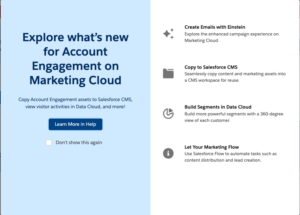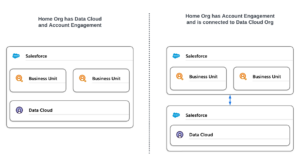Get Your Cookies in Order
Making Site Cookies Compliant
We know that every time we mention cookies, you’re hoping that it’s about dessert. Well, sorry to disappoint you yet again, but these cookies have delicious, nutritious data! Account Engagement (Pardot) uses first-party cookies to improve user experience and to get you that tasty data. Data that allows you to gain valuable insights into the minds of your prospects, which will boost that conversion rate!
The thing is, you have to do it right. Those first-party cookies need to be accepted by the user, and if you don’t have them set up right, it could cost you. Let’s look at what you need to know.


How Does Account Engagement Use Cookies?
Pardot/Account Engagement uses those tasty cookies to track the behavior of prospects while they’re on your website. They give us those valuable insights that we talked about while also respecting user privacy. Third-party cookies–like the ones used in advertising–can be blocked. Most browsers come with third-party cookie blockers now (and Google has already stated that they’re eliminating them), but first-party cookies don’t track between different sites and are stored in your domain, which gives you greater control over the tracking, and provides a better user experience on your site.
When your browser remembers a login for a certain site? First-party cookies. When a site remembers your specific preferences like language and dark mode? First-party cookies, again! Imagine having to input all that data every time you visit a site. Exhausting!
Need Assistance?
Fill out the form below and a Account Engagement (Pardot) expert will contact you to discuss this topic more in depth.
Consent is Key
While we think we can all agree that these cookies make the user experience a lot smoother, you can’t just force them on your site visitors. The data they collect is still considered to be private user data and therefore must be in compliance with laws like CalOPPA and the GDPR. You cannot simply implement this code without telling your visitors abou it.


You Need a Banner
Lucky for us, we’re all Account Engagement (Pardot) users here… Even if they are calling it by a new name that we’re not necessarily fans of. We’re able to achieve full cookie compliance without having to fight with Google Tag Manager for hours.
In the Salesforce Spring Release 2022, a JavaScript Consent & Tracking API was launched to manage website tracking cookie opt-in and opt-out, allowing you to manage your cookies and their compliance all in one place!
How Do I Enable The Consent and Tracking API? Repeat After Us:
1. Go to ‘Settings’ in Account Engagement.
2. Select ‘Account Engagement Settings’ in the Lightning app.
3. Click ‘Edit’ and then select ‘Activate the Tracking & Consent JavaScript API’.
4. Hit ‘Save’.
Now it’s ready for your web developer!
Am I Compliant Now?
Nope! Not fully! Stick with us, because we still have a bit further to go.
In your account ‘Domain Management’ section, there’s some tracking code that needs to be replaced. What’s there is simple, and doesn’t quite fully do the job.
Then, depending on the number of cookies and your current setup, you’ll need a custom-made banner script that aligns with third-party tracking systems that have cookies and the Account Engagement/Pardot cookie opt-in.
The banner also can’t be a one-time deal. Your users need to be able to navigate back to it at any time if they change their mind in regard to allowing you access to their information. There’s script you can add for this, or there are paid consent management tools you can use that make it simple.


That Sounds… Daunting
It can be, but it doesn’t have to be something that overwhelms you. It feeds right into what we do at SLX, which is managing your MCAE and Salesforce automation, making your data beautiful and actionable, and yes, even making your site cookie-compliant! All this is included in our revolutionary Rev-Ops subscription model. Pretty good deal, if you ask us.
These changes can be easy to make…
Stop feeling overwhelmed by the tiny details that hinder your progress and eat up your valuable time. Schedule a demo today, and let us show you how light your plate can be once SLX takes things off of it!
This Pardot article written by:
SalesLabX
We help organizations optimize and automate their marketing & sales process using Pardot, Salesforce, and our in house design team. Born in the heart of Austin, Texas. Discover The Science Behind Your Sales.
Original Pardot Article: https://rss.app/articles/cb4e791f6f6d729c005554476cdab4891350132e1270a0e4d1ed920886837488f113bd113a878133aaf7772e80494fcf398436b2970d
Find more great Pardot articles at https://saleslabx.com/resources/
Pardot Experts Blog
We have categorized all the different Pardot articles by topics.
Pardot Topic Categories
- Account Based Marketing (ABM) (7)
- Business Units (14)
- ChatGPT / AI (3)
- Completion Actions (5)
- Connectors (10)
- Custom Redirects (4)
- Data Cloud (3)
- Demand Generation (8)
- Dynamic Content (7)
- Einstein Features (11)
- Email Delivery (17)
- Email Open Rates (3)
- Pardot A/B Testing (2)
- Email Mailability (16)
- Do Not Email (1)
- Double Opt-in (2)
- Opt Out / Unsubscribe (14)
- Email Preferences Page (6)
- Engagement Studio (16)
- Industries (1)
- Non Profit (1)
- Landing Pages (9)
- Lead Generation (1)
- Lead Management (13)
- Lead Routing (3)
- Lead Scoring (16)
- Leads (3)
- Marketing Analytics – B2BMA (9)
- Marketing Automation (1)
- Marketing Cloud (3)
- Marketing Cloud Account Engagement (4)
- Marketing Cloud Growth (2)
- New Pardot Features (6)
- Opportunities (2)
- Optimization (2)
- Pardot Admin (65)
- Duplicates (1)
- Marketing Ops (1)
- Pardot Alerts (1)
- Pardot API (2)
- Pardot Automations (3)
- Pardot Careers (12)
- Pardot Certifications (4)
- Pardot Consulting (1)
- Pardot Cookies (4)
- Pardot Custom Objects (3)
- Pardot Email Builder (8)
- Pardot Email Templates (10)
- HML (6)
- Pardot Events (17)
- Pardot External Actions (1)
- Pardot External Activities (4)
- Pardot Forms (29)
- Form Handlers (8)
- Pardot Integrations (21)
- Data Cloud (2)
- Slack (1)
- Pardot Lead Grading (5)
- Pardot Lead Source (2)
- Pardot Lightning (1)
- Pardot Migration (1)
- Pardot Nurture / Drip Campaigns (2)
- Pardot Personalization (3)
- Pardot Profiles (1)
- Pardot Releases (18)
- Pardot Sandboxes (2)
- Pardot Segmentation (5)
- Pardot Strategy (7)
- Pardot Sync (2)
- Pardot Sync Errors (1)
- Pardot Tracker Domains (5)
- Pardot Training (3)
- Pardot Vs Other MAPs (4)
- Pardot Website Tracking (2)
- Reporting (22)
- Salesforce and Pardot (31)
- Marketing Data Sharing (2)
- Pardot Users (3)
- Salesforce Automation (5)
- Salesforce Flows (2)
- Salesforce Campaigns (22)
- Salesforce CRM (3)
- Record Types (1)
- Salesforce Engage (3)
- Salesforce Queues (2)
- Security and Privacy (1)
- Tags (3)
- The Authors (540)
- Cheshire Impact (9)
- Greenkey Digital (55)
- Invado Solutions (37)
- Jenna Molby (9)
- Marcloud Consulting (6)
- Nebula Consulting (67)
- Pardot Geeks (44)
- Salesforce Ben | The Drip (242)
- SalesLabX (16)
- Slalom (4)
- Unfettered Marketing (51)
- Uncategorized (1)
- Website Tracking (2)
- Website Search (1)
More Pardot Articles
See all posts
This Pardot article written by:
SalesLabX
We help organizations optimize and automate their marketing & sales process using Pardot, Salesforce, and our in house design team. Born in the heart of Austin, Texas. Discover The Science Behind Your Sales.
Original Pardot Article: https://rss.app/articles/cb4e791f6f6d729c005554476cdab4891350132e1270a0e4d1ed920886837488f113bd113a878133aaf7772e80494fcf398436b2970d
Find more great Pardot articles at https://saleslabx.com/resources/






